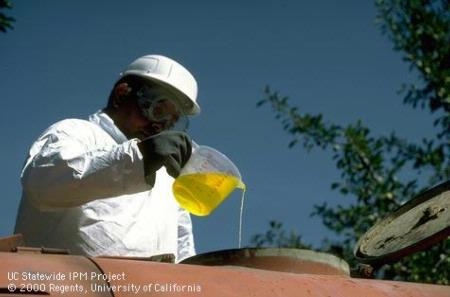- Posted By: Chris M. Webb
- Written by: Nick Sakovich, UCCE Farm Advisor Emeritus, Ventura County
Introduction
Dry Root Rot has menaced growers in Ventura County for many years. In the ‘50's and ‘60's it seemed most prevalent on older orange trees. A few years after the wet winter of 1968-
69, dry root rot became an increasing problem among citrus trees of all ages. At that time, most of the damaged trees were on sweet rootstock (susceptible to Phytophthora), and growing in fine-textured soils or soils with poor drainage. A few years after another wet winter/spring (of 1983), dry root rot again reared its ugly head, but this time predominately on young lemons.
The disease is caused by the fungus, Fusarium solani. This fungus is most likely present in all citrus soils in California. It is a weak pathogen in that by itself it will not attack a healthy
tree. However, experiments conducted in the early 1980’s by Dr. Gary Bender, showed that when seedlings were girdled, root invasion occurred. In the field, the fungus can infect trees once gophers have girdled the roots or crown. A Phytophthora infection will also predispose trees to Fusarium, as will asphyxiation. Therefore, the mere presence of the fungus in the orchard soil will not lead to the disease.
Description
Fusarium is a soil borne fungus that invades the root system. Once infected, the entire root will turn reddish-purple to grayish-black. This is in contrast to a Phytophthora infection which, in many cases, will attack only the feeder roots, but when larger roots are infected, only the inner bark is decayed and it does not discolor the wood. In addition, when observing the cross section of a dry root rot infected trunk, a grayishbrown discoloration in the wood tissue can be observed.
Dry root rot is a root disease, but symptoms of the root decline are seen above ground. They are similar to any of the root and crown disorders such as Phytophthora root rot, oak root rot fungus (Armillaria) and gophers. The trees lack vigor, leaves begin to turn yellow and eventually drop (especially in hot weather) causing twig dieback. Finally, the foliage will
become so sparse that one will be able to see through the canopy of the tree. A period of two to three years may pass from the time of invasion until noticeable wilt. Many times, the tree will collapse in the summer, after a period of prolonged heat. In the case of dry root rot, the collapse is so rapid that the tree dies with all the leaves still on the tree. When looking for symptoms of dry root rot, keep an eye out for symptoms of other maladies as well — Phytophthora, oak root rot fungus and gophers being the most prevalent.
As mentioned previously, in order for Fusarium to infect a tree, there must be a predisposing factor such as girdling from gopher feeding. However, since many trees collapse from dry root rot without any apparent predisposing factor, there are obviously other factors which we have yet to identify. Therefore, in 1998, a grower survey was developed, along with
intensive soil and leaf sampling, to attempt to identify as many new predisposing factors as possible. They might be elements in the soil, either deficiencies or excesses, or specific cultural practices such as irrigation patterns or fertilizer practices. Twenty orchards were identified from which 20 soil and 20 leaf samples were taken in diseased areas and another 20 soil and 20 leaf samples were taken from adjacent healthy areas. The
owners or managers of the properties were given a questionnaire to complete regarding a variety of cultural operations. The objective was to identify those factors that would correlate well to trees becoming infected with dry root rot.
Survey Results
Soil analysis - The following laboratory procedures were conducted to see if there was any correlation between the disease and either deficiencies or toxicities of these elements or
conditions: sodium, boron, salt level, pH and soil type (sand, loam, clay). For these elements or conditions, no correlation was found. It would appear that for our sampling sites, these conditions, whether favorable or not (toxic or deficient), did not play a major role in predisposing the tree to dry root rot.
Leaf analysis - The following elements were analyzed for their concentration within the leaf: nitrogen, potassium, phosphate, manganese, magnesium and zinc. Of these, three correlations were found. Zinc and manganese levels were substantially higher in diseased trees. The third correlation showed a potassium deficiency in diseased trees. However, we do not believe that dry root rot is caused by elevated levels of zinc or manganese, or by potassium deficiency, but rather are a result of the disease. Unfortunately, it seems that we have still not identified any elements in leaf analysis that truly correlates and points to a predisposing factor for disease development.
Grower survey - The grower survey included questions on planting site (location, wind, previous crop, fumigation etc.), trees (source, type, rootstock, etc.), and cultural practices (irrigation, fertilization, gophers, history of Phytophthora, water quality, etc). Through statistical analysis it was found that the healthy and diseased sites were significantly different with reference to three conditions or situations: 1.) The presence of Phytophthora in an orchard will increase the chance of those trees succumbing to dry root rot. 2.) Orchards that have been fumigated have a less likely chance of succumbing to dry root rot. 3.) Balled vs. Container Plants -- growers were asked if their trees were balled or container
grown nursery plants. Healthy sites were significantly more likely to have been planted with balled trees (73% vs 33%). The results of this analysis were not strong, but rather they
suggest that there is a relationship between the disease and the type of tree planted - balled or container grown - and suggesting in favor of a balled tree for a healthy orchard.
Control Measures – What Works and What Does Not
Early experiments conducted by Menge, Ohr and Sakovich showed that the following circumstances or operations do not influence the incidence of this disease: fungicidal treatments, wounding the tap root at time of planting, sandy versus clay textured soils, spring versus fall planting and soil mounding.
Rootstocks. In choosing your nursery tree, the choice of rootstock is not important in that, as far as we know, all rootstocks are susceptible to this disease. However, since Phytophthora is a major component in dry root rot development, choosing a rootstock like sweet orange would certainly put those trees in a high risk category. We recommend that growers use Phytophthora resistant rootstocks like C35 or Citrumelo.
Fumigation. According to the survey, it would be advantageous to fumigate before planting. Methyl bromide, although expensive, is the best fumigant as it is a complete biocide. If one chooses not to fumigate, the alternative would be a number of fungicide/nematicide applications to the newly planted trees. Generally speaking, this may work well with trees planted on a rootstock like Citrumelo or C35.
Phytophthora. Publications written in the 1970's, and again noted by our survey, showed that Phytophthora is a major culprit in the dry root rot complex. To control dry root rot, it is essential that the Phytophthora, when present, be controlled. This can be accomplished by fungicidal treatments, and by the proper application and timing of irrigation water. Overwatering creates a favorable environment for the multiplication of the Phytophthora fungus.
Gophers. It is well known that gopher damage provides entry points for Fusarium. Controlling gophers is an important factor in reducing the potential of infection by Fusarium.
Control
We presently have no direct control for dry root rot. To control the disease, we must control the predisposing factors such as gophers, Phytophthora, poor drainage and over-watering. If the predisposing factor(s) cannot be identified for a given diseased orchard, it will indeed be difficult to control the disease. Two things are certain though: 1.) There are no chemicals to date which will control this disease; and 2.) Presently, there are no rootstocks resistant to the disease.
Future Projects
There are a number of ongoing research projects in Ventura County attempting to unravel the dry root rot mystery. Some of these projects target identification of more predisposing
factors. Still other projects are aimed at increasing understanding of the fungus itself and how the disease occurs.
Trial 1 - Addresses the potential problem of using a soil auger in clay soils to dig the planting hole. We suspect that doing this will create a planting hole with slick sides, having the effect of sealing the hole. This will temporarily hamper the roots from growing outward into the surrounding soil, thus creating a potbound condition and predisposing the trees to dry root rot.
Trial 2 – In an orchard with a history of dry root rot, we are replanting with container grown nursery trees versus bareroot (balled) nursery trees. As indicated by our survey, there is a correlation between container grown trees and the occurrence of this disease. In this experiment we will be able to verify this relationship.
Trial 3 – Same as Trial 2, but using “bench” or “J” rooted trees versus normal nursery trees. This will enable us to see if certain types of abnormal root growth predispose trees to the
disease. Another treatment in this test is the application of unincorporated gypsum to the soil.
In the above trials, we are growing comparison trees. If our supposition is correct, within five years a larger number of those trees with a predisposing factor to dry root rot should die. For example in trial 2, if container trees are more predisposed to dry root rot than balled trees, a higher proportion of those will die compared to the bareroot trees.
Additional projects
1. We are analyzing healthy trees compared to diseased trees for their starch levels to see if starch depletion
may play a role in the onset of this disease. Preliminary results so far, indicate no correlation between starch depletion and the disease.
2. The mushroom fungus Coprinus is often observed growing next to diseased trees. We are presently investigating this relationship to see if Coprinus may be a factor in the dry root rot complex.
3. Although we are dealing with a known species, Fusarium solani, it is possible that we are dealing with more than one race of this species. One race may be a toxin producer causing the trees to succumb to dry root rot. The other may be a non-toxin producer where no disease is produced. Through molecular analysis, we are investigating if different strains of
Fusarium do exist.
On a closing note, it has recently been discovered that there is a triggering mechanism which will cause this fungus under certain, as yet unknown, environmental conditions to begin producing chemicals which are toxic to plants. This mechanism is governed by a gene which is present on a unique type of chromosome called a dispensable chromosome. This entire chromosome may be ignored for years and the fungus may not be pathogenic. However, when utilized, this chromosome harbors toxin genes, which may turn the fungus into the dry root rot pathogen. This is a real breakthrough. The key now will be to ascertain what conditions trigger the change and how we can prevent it.
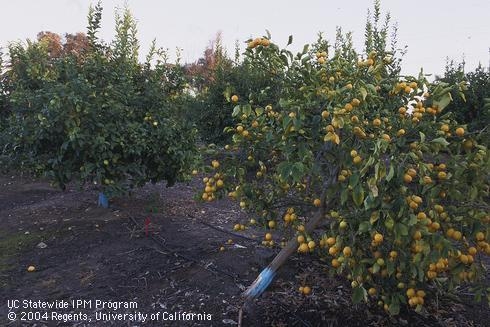
- Posted By: Chris M. Webb
- Written by: By C. Thomas Chao* and Pachanoor S. Devanand Department of Botany and Plant Sciences, UC Riverside *Formerly Dept of Botany and Plant Sciences, UCR. Now at USDA Plant Genetic Resources
The date palm (Phoenix dactylifera L.) made its way to California through the Spanish missions in the late seventeenth century. In its native ranges of North Africa and the Middle East, the date provided food, fiber and shelter. As commercial date production established in the interior valleys of California and Arizona, growers sought out new varieties. Introductions of varieties from Algeria, Tunisia, Egypt and Iraq between 1890 and 1922, laid the foundations of the modern California date industry. W.T. Swingle brought offshoots of ‘Deglet Noor’ to California in 1900. Recognized as a superior variety for three hundred years in the oases of Algeria and other North African countries, ‘Deglet Noor’ is now one of the most significant cultivars in California and worldwide. In 1927, Swingle also introduced the ‘Medjool’ date to California. ‘Medjool’, probably originated in the Tafilat district of Morocco, takes its place beside ‘Deglet Noor’ as one of our most important date varieties.
From its beginnings as few thousand imported offshoots, the California date industry has grown to annual harvests totaling $23-30 million dollars, according to 2001 USDA statistics. The approximately 5,600 acres of date palms in California account for more than 95% of the U.S. industry, supplying dates for consumption and mature trees for the expanding landscape market. The varieties ‘Deglet Noor’ and ‘Medjool’, amongst a few others, remain the mainstay of this strong niche landscape industry. While there have been no important cultivars introduced into the U.S. in recent years, there are over three thousand different cultivars grown worldwide. Examining these cultivars and making comparisons with those cultivars grown in California, will allow researchers to make new introductions best suited for our industry.
The long history of cultivation has obscured the origins of the date palm, thought to be a native of western India or possibly southern Iraq. Identifying cultivars can be difficult, as this is done primarily through morphological characteristics such as the fruit, leaf bases or spines. Environmental factors such as soil or weather can influence these characteristics, which are generally only observable on mature trees of at least 3-5 years of age. The names associated with date cultivars also create some confusion. In some parts of the world, a date known by one name at an oasis might be called something completely different a few hundred miles away. To add to the confusion, dates also exhibit intra-varietal variations. These variations, such as differences in fruit size, ripening time or vegetative characteristics, were first reported in the early 1920’s. Researchers originally thought the differences between palms of one variety were due to the chance that the plant had come from a seedling instead of an offshoot thus having different varietal characteristics because it was a hybrid and not a clone from the parent plant. Those plants were grown and marketed under the name of the parent cultivar. Modern researchers, using amplified fragment length polymorphism (AFLP) markers, a polymerase chain reaction (PCR) based molecular markers, can now evaluate genetic diversity and fingerprinting of the date cultivars. In a recent study at UC Riverside, we examined 23 samples of ‘Medjool’ and 33 samples of ‘Deglet Noor’ date using AFLP markers (The Journal of Horticultural Science and Biotechnology, 2003, 78(5): 405-409). The samples for this study were collected from the USDA National Clonal Germplasm Repository for Citrus and Dates at the UC Coachella Valley Research Station, Thermal, CA and from commercial date gardens in the Coachella Valley. Our results showed that there is almost no genetic difference amongst the 33 ‘Deglet Noor’ date samples; however we identified a wide range in genetic variation within the ‘Medjool’ samples. Among 23 ‘Medjool’ date samples tested, 3 had the same genetic profiles. In total, we identified 20 different types of ‘Medjool’ dates. How can we explain such large difference found in ‘Medjool’ dates in California? The differences could have originated when horticulturists originally introduced ‘Medjool’ into California in the early 1900s. The plants could have been mistakenly identified, mislabeled, or mistakenly propagated from seedlings instead of clonal offshoots. Another possible explanation for the genetic variation could be that ‘Medjool’ palms have a high rate of mutation. The differences we found in ‘Medjool’, however, are too large to be explained by a high mutation rate, we believe another explanation is more likely. We propose that the ‘Medjool’ date that was introduced into California originated from a “landrace” variety in the Tafilalt district of Morocco, where ‘Medjool’ was initially selected. A “landrace” variety means that the variety is endemic to an area (in the case of ‘Medjool’ in the Tafilalt district of Morocco), it is a mixture of different genotypes and well adapted to the local environment. It is possible that the initial introductions of ‘Medjool’ were in reality different genotypes of ‘Medjool’ and these different genotypes exist in current plantings. On the contrary, all 33 ‘Deglet Noor’ dates that we tested are almost the same genetically. ‘Deglet Noor’ seems to exist as a pure variety without much variation.
Growers in California have observed differences in fruit quality and yield of ‘Medjool’ date in the past, but the variation always have been attributed to xenia effect, location, environmental, or management practices. Our results imply that the differences in production between ‘Medjool’ date palms may be due to genetic differences and not just cultural differences. Field testing is needed to determine if the differences in fruit quality and yield between plants is related to genetic differences between plants. For this, we need to plant a trial where we are able to evaluate genetically different strains of ‘Medjool’ palms grown under the same environmental conditions. Potentially, some strains of ‘Medjool’ may have higher yield and better fruit quality than other selections; these can be selected for propagation thereby having the potential to increase grower’s returns.
In the future, we would like to examine 30-50 different ‘Medjool’ samples collected from Morocco using the AFLP markers to confirm or dispute the possibility that ‘Medjool’ date exists as a landrace variety in Morocco. We also are collecting samples of offshoots from the same ‘Medjool’ palm to determine if high mutation rate exists in ‘Medjool’ dates. By learning more about the varieties grown in California and abroad, we hope to select varieties that would increase the vitality of the date industry in California.
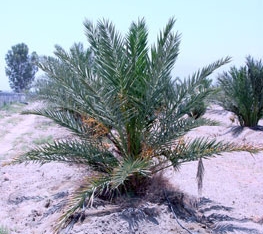
- Posted By: Chris M. Webb
- Written by: Gary Bender, David Crowley and Mary Lu Arpaia
This is the story of a remarkable avocado rootstock trial that was set up in 2004, lost to the freeze of January 2007, recovered (mostly) and had its first harvest in spring of 2010. But the real story is how some of the rootstocks bore at a really high rate with water that was so saline that almost killed most of our California rootstocks.
As part of Crowley and Arpaia's salinity rootstock trial, in cooperation with farm advisors and several growers, and funded by the California Avocado Commission, this particular trial was planted in 2004 at the Nick Stehly Ranch in Valley Center. The trial had 10 different rootstocks all grafted with Hass scions. Twenty trees of each rootstock were planted in a randomized and replicated block design: the rootstocks were Duke 7, Spencer, Parida, VC 44, VC 207,VC 801, VC 218, PP14 (Uzi), PP 16 (Rio Frio) and PP24 (Steddom). The VC series are rootstocks selected in Israel for tolerance to salinity, and the PP series are rootstocks selected for root rot tolerance by Dr. John Menge at the Plant Pathology Dept., U.C. Riverside. At the time of planting it was not known how the PP trees would react to salinity.
In Spring 2005 we planted six Hass/Dusa trees into vacant spots in the trial. These trees were left over from a Bender irrigation trial on another part of the ranch.
The trees were grown with highly saline irrigation water with an average EC of 2.5 and chloride levels of approximately 300 ppm. Needless to say, most of these trees suffered greatly with severe tip-burn and some of the trees almost died. But some looked better than others and we were waiting for the first harvest. In Spring 2006 some the trees set fruit and we expected the first harvest to be in 2007. But then disaster struck!
In January 2007 we had a serious freeze in San Diego County. Nick Stehly called us to let us know that he recorded a temperature of 18° F in our plot. All of the trees looked like they had died and we gave up on this plot and went on to other trials.
But the irrigators didn't give up! They kept pruning the dead wood out of the trees that did not die and gradually brought most of the trees back to life. But the trees were still being irrigated with the saline water, except for one important difference.
The Stehly family liked to swim in the reservoir about three times during each summer. So they would fill the small reservoir at the end of the ranch that supplied our trial, with Metropolitan Water District water with an EC of 0.7 – 0.9. After swimming they used this water for an irrigation of the trial. Amazingly, this “leaching” irrigation was apparently enough to keep the trees growing without too much tip-burn, and the irrigator reported to Nick in January, 2010 that we had enough fruit for a harvest.
The first harvest was completed in March,2010. The data for mean pounds of fruit per tree is presented in Figure 1. The number of surviving trees after the freeze of 2007 is presented in Table 1.
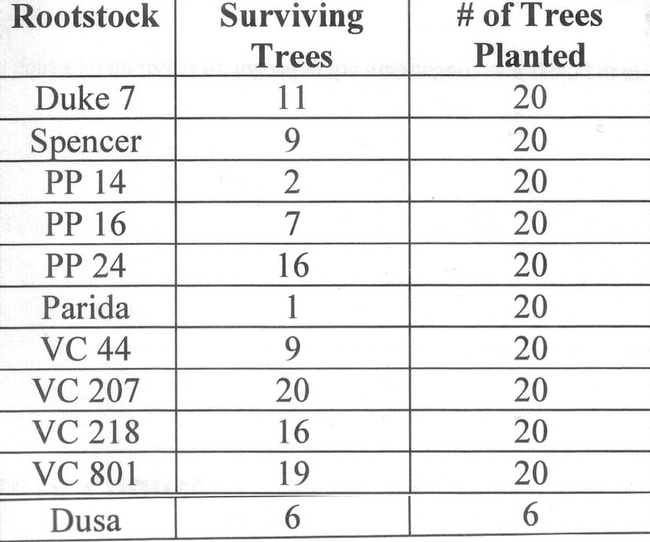
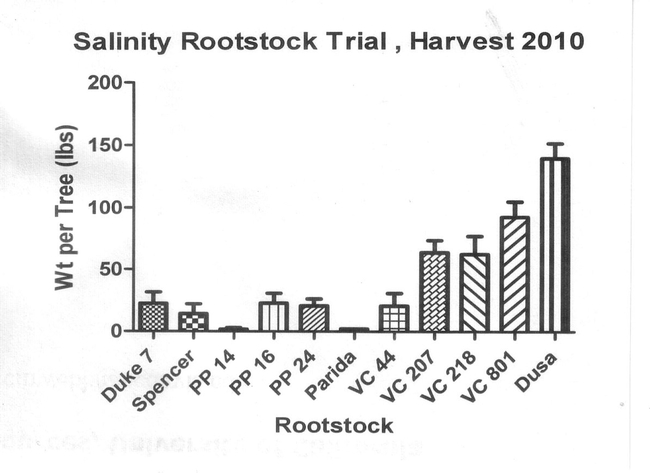
The mean wt of Hass avocados for the VC 801 rootstock was 92.2 lbs, and the mean wt for the Dusa rootstock was 139 lb. If this is compared to the San Diego County average yield of 7000 lbs per acre (about 70 lbs per tree), it would indicate that we might be making progress in finding some better rootstocks for use with some of our saline irrigation waters. However, as we all know, you can't base any conclusions on one year of yield data. We need to have at least three years of yield data to even begin to make a conclusion.
Our hats off to the irrigators at the Stehly Ranch, and to the Stehly family for their cooperation (and their reservoir/swimming pool). You never know what might show up in some of these older rootstock trials.
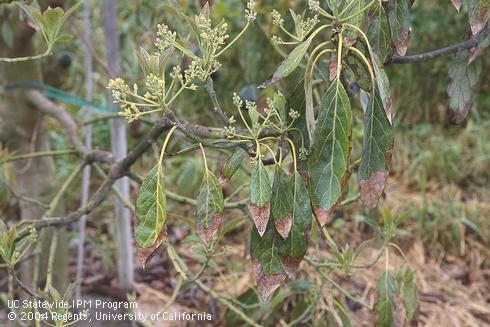
- Author: Neil V O'Connell
Recently a six-year old W. Murcott orchard was evaluated for causes of tree decline. A high percentage of the trees exhibited damage to the bark of the tree generally from the soil line up 6-8 inches. (Fig.2) In some instances the tree had been almost totally girdled. On close inspection of the trunk, an open hole 4-5 inches in diameter was found at the base of the tree. (Fig.3)
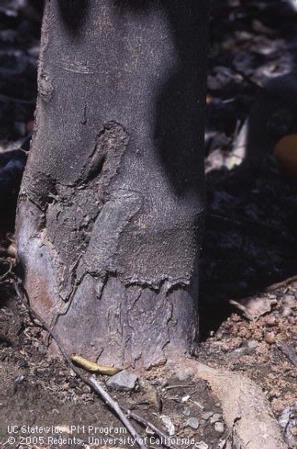
Microtus are often found where there is grass cover. They generally do not invade cultivated crops until the crop is tall enough to provide food and shelter. Meadow mice are active all year round. They forage at any time during the day or night but are chiefly nocturnal. They are usually found in colonies marked by numerous -2-- inch wide surface runways though matted grass. Small piles of brownish feces and short pieces of grass stems along the runways are evidence of activity. The burrows consist of extensive underground tunnels, nest chambers and storage chambers. Home range is typically small, less than a 60 foot radius in the case of “M.californicus”. All meadow mice swim well. Therefore, irrigation ditches will not serve as effective barriers against meadow mice movement into fields. Meadow mice may forage beyond the sheltered runways. Food consists of tubers, roots, seeds, grain, and succulent stems and leaves.
Females breed at 4 to 6 weeks of age with liter size of “M.californicus” averaging around 4. Under natural conditions a female Microtus may produce from 5 to 10 litters a year. The major breeding season corresponds with the season of forage growth. Microtus populations build up to a peak every 3 to 4 years, followed by a rapid decline during the next breeding season. The exact causes of the cycle of buildup and decline are not known, though disease, food shortages, physiological stress from overcrowding, and other factors may be involved. It is assumed that in cultivated areas Microtus populations are permanently based in favorable habitat such as roadsides, canal banks or adjacent noncultivated land. Invasion of cultivated cropland occurs when the population builds up or when the wild habitat becomes unfavorable. Coyotes, badgers, weasels, snakes, hawks, owls, herons and gulls are among the principal predators. It is believed that predators are not able to prevent or control a population eruption because of the birth rate of the fast breeding Microtus population. Meadow mice are classified as nongame mammals by the California Fish and Game Code. Nongame mammals, which are found to be injuring growing crops may be taken at any time or in any manner by the owner. Management: The most effective management options in an orchard situation are a reduction in ground cover and the use of toxic baits. Meadow mice are cover dependent. If cover is the management of choice - typically weed or grass, the cover can be removed from around the base of a tree, this often solves meadow mice problems. In situations where cover removal is not possible or is insufficient to solve the problem, the next best option is the use of toxic baits. Many bait carriers are used (e.g., oat groats, wheat bait). Baits: Crimped oat groats is the most satisfactory bait although crimped whole oats are used (e.g., oat groats, wheat grains, pelletized formulations, etc., but crimped oat groats have typically been most effective). The primary toxicants used for meadow mouse control include zinc phosphide, diphacinone, and chlorophacinone. Directions for management including baiting can be obtained by contacting the Agricultural Commissioner’s Office.
* Portions taken from J.P.Clark Vertebrate Pest Control
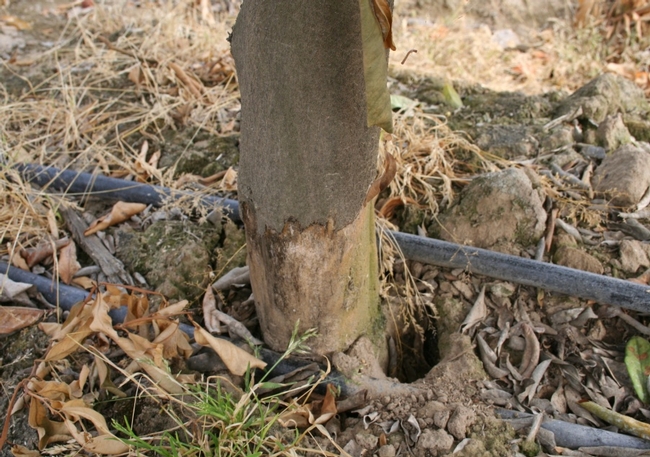
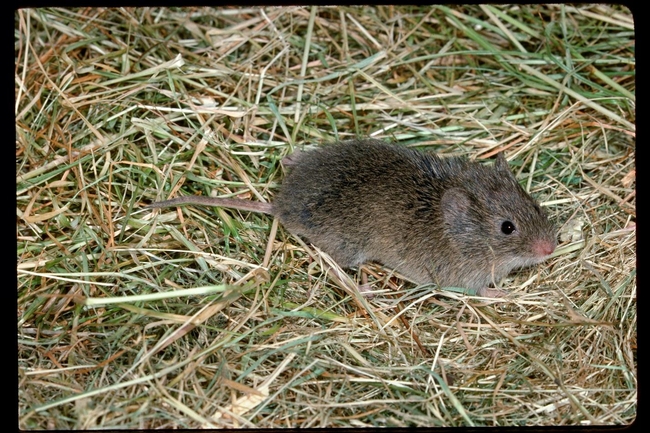
- Posted By: Jeannette E. Warnert
- Written by: Franz Niederholzer, UC Farm Advisor, Sutter/Yuba Counties and Rhonda Smith, UC Farm Advisor, Sonoma Co.
Agricultural spray adjuvants are materials added to the spray tank when loading the sprayer. They include products classified as activator adjuvants and marketed as wetters/spreaders, stickers, humectants, and/or penetrators. Activator adjuvants are marketed to improve the performance of pesticides and foliar fertilizers.
Activator adjuvants can have a place in tree (and vine) crop sprays, but matching the material to the job can be tricky. A bad match can lead to minor or major losses to the grower. Minor losses can result from excess spreading and pesticide runoff from the target plant. Phytotoxicity can cause major damage.
This article describes ingredients and functions of activator adjuvants commonly sprayed on tree and vine crops. Suggestions regarding activator adjuvant selection are offered. Growers must make their own activator adjuvant use decisions based on experience, particular needs, and risk tolerance.
Do I need to add an activator adjuvant?
Read and follow the specific instructions on the label. If the pesticide or foliar fertilizer label indicates the product should be used with certain types or brand of adjuvant(s), that’s what you need to use.
Do I want to add an activator adjuvant?
If the label includes phrases such as "use of an adjuvant may improve results" or “complete coverage is needed for best results” then you may want to look into selecting and using an appropriate activator adjuvant. Before proceeding with use of an activator adjuvant, first look at your existing spray program. Are you already doing the best spray job you can? Good spray coverage begins with proper sprayer calibration and set up. Is your sprayer calibration dialed in for different stages of canopy development?
Optimum sprayer set up – gallons of spray per acre, ground speed, fan output, and nozzle selection/arrangement-- changes from dormant to bloom to early growing season to preharvest sprays. Adjusting your sprayer to best match orchard and vineyard conditions at each general stage in canopy development is the foundation of an effective, efficient spray program. An activator adjuvant will not make up forexcessive tractor speed, poor nozzle arrangement and/or worn nozzles. Your money is best spent first dialing in your sprayer(s) for the whole season, before considering an extra material in the tank (that is not required on the label). If you have your sprayer(s) dialed in for each orchard and stage of growth, now is the time to say “OK, I want to think about a little extra boost to my spray job”.
Which activator adjuvant properties do I want?
First, know the properties of the pesticide you will use. Does it work on the plant surface or inside the plant? This is a key point in selecting adjuvants. Here is a quick review of the main classifications and characteristics of activator adjuvants as they currently appear in the field. Note: Certain products can provide more than one adjuvant property – that can be beneficial in the field. For example, non-ionic surfactants can work as surfactants and penetrators, depending on use rate.
Wetters/spreaders: These materials contain surfactants that decrease the contact angle and increase the spreading of the spray droplet on the target. High rates of wetters/spreaders may also increase penetration of pesticide into the target tissue (leaves or fruit), potentially causing phytotoxicity. Excessive spreading of pesticide spray solution and runoff from the target may result when using a new or higher rate of spreader -- especially when using silicon “super-spreaders”. Test new combinations of spreader material(s) and spray volume before regular use. Spray volume per acre or adjuvant use rate will probably have to be reduced if a labeled rate of adjuvant provides excessive spreading.
To check for excessive spreading, place alength of black plastic sheeting under several trees or vines in a row. Secure the plastic with spikes, wire staples, and/or weights. Spray the new adjuvant and pesticide combination using your current sprayer set up. Reenter the field right after spraying, wearing appropriate PPE, and evaluate coverage. If material is pooling at the lower portion of leaves and/or fruit, excessive spreading is occurring. Check to see if pooling is occurring only in a certain area(s) of the canopy or throughout the canopy. If more spray solution is landing on the black plastic tarp under the trees/vines than between them, then runoff is occurring. [Some ground deposit should be expected from standard airblast sprayer use.]
Compare the results of your adjuvant test with a similar application of your current pesticide/adjuvant combination on another portion of the row. If there is no pooling or runoff with the new adjuvant in the tank, you can use the adjuvant with confidence. A lack of pooling or run off with the new adjuvant also might mean that your old sprayer setup and tank mix didn’t deliver adequate coverage. If the test with the new adjuvant showed pooling on leaves and/or runoff on the ground, you have several choices.
- You can reduce spray volume per acre by replacing some or all nozzles with smaller nozzle sizes on the sprayer in an effort to reduce overspreading. If you saw overspreading on some portions of the canopy, but not others, reduce nozzle size only on the part of the spray boom that targets the over-sprayed part of the canopy. Recheck spray coverage if nozzling changes were made.
- Reduce the adjuvant rate and recheck coverage/spreading.
- You can just go back to your established program without the new adjuvant. What’s the “best” course of action? That depends on your farming operation.Reducing spray volume per acre means more ground covered per full spray tank – a potential time and cost savings. If spraying is done during the heat of the day in hot, dry climate, spray water evaporation is a major issue and it may be best to keep the higher spray volume and reduce the spreader rate or eliminate it entirely. Checking coverage and overspreading allows you to make the best decision possible; avoid damage and, hopefully, save money. All farming operations are different. Make the choice that best fits your farm.
Stickers: These adjuvants can increase the retention time of the pesticide on the leaf and reduce rain wash off. They may limit movement of systemic pesticides into the plant, and are probably most beneficial when used with protectant materials (cover sprays). Do you overhead irrigate? Is there rain on the horizon? If you answer yes to either one of these questions, you may benefit from using a sticker.
Humectants: Under low humidity conditions humectants can help reduce spray droplet evaporation before and after deposition on the plant. This is especially valuable when small droplets and/or materials that must be absorbed into the plant (systemic pesticides, PGRs, nutrients, etc.) are used in the summer under high temperature and low relative humidity conditions.
Penetrators: Frequently used with herbicides, these products include oils (petroleum, vegetable, or modified vegetable oils) and non-ionic surfactants used at higher rates. In crop sprays, penetrators can be used to increase absorption of systemic pesticides (for example, oil with Agri-Mek) as well as translaminar materials. Penetrator adjuvants should be used with caution oravoided entirely with surface active pesticides such as cover sprays or else phyto may result. Finally, some penetrators can increase the rain-fastness of some pesticides.
Which adjuvant material should I select?
Use a product intended for crop spraying. Many activator adjuvants were developed and intended for use with herbicides. Products that are advertised for use with plant growth regulators should have a higher chance of crop safety compared with those that don't. This is still no guarantee of a phyto-free application. Ask for help from your PCA or the adjuvant manufacturer’s sales rep. How much do they know about the particular activator adjuvant in the spray mix you are planning? Can they show you the kind of information on a single product similar to what you can find at: http://www.ast-us.com? (This website is intended as an example, not an endorsement of the web pages it contains including specific adjuvants.)
Will the adjuvant I selected work in the spray I’m planning?
If you choose to use an adjuvant that is not specifically listed on the pesticide or foliar fertilizer label, jar test the planned spray solution first. Use the same spray water source. Include all leaf feeds, other adjuvants, and pesticide(s) that you plan to put in the spray tank. Do this before tank mixing these materials. A lot of time and money rides on effective pesticide application. Do your homework before the spray tank is filled and you will be well on your way to solid results.
